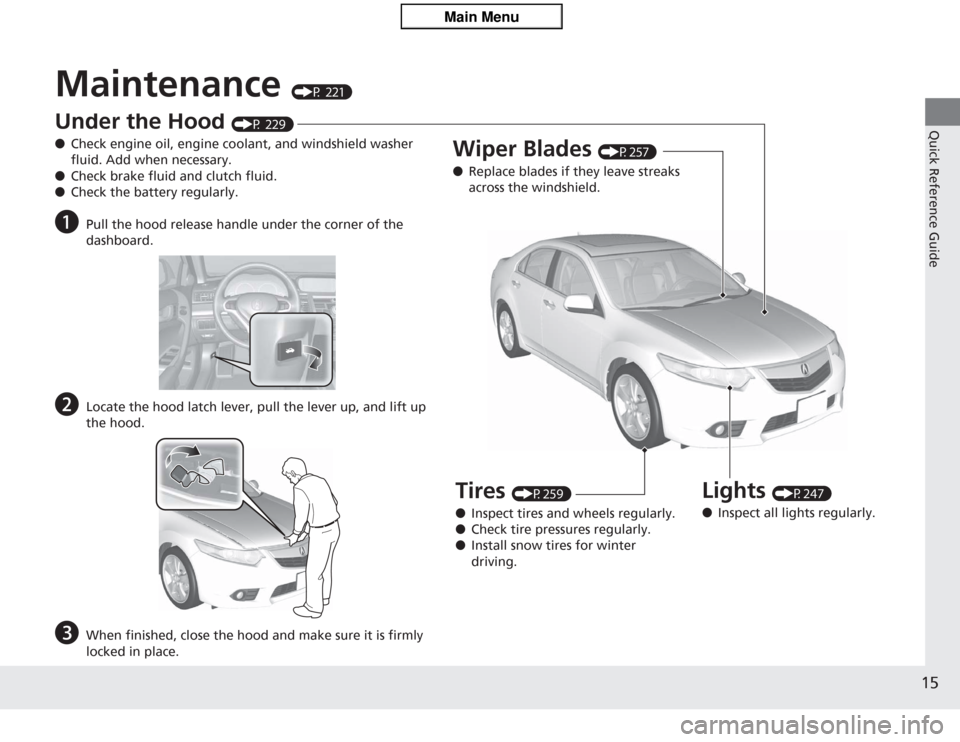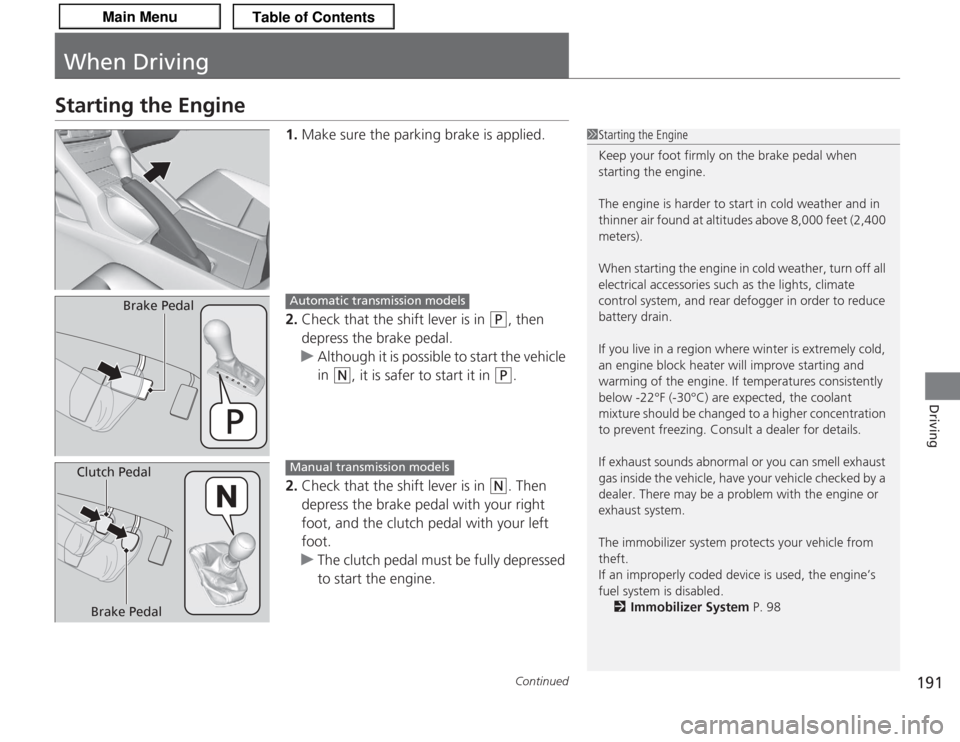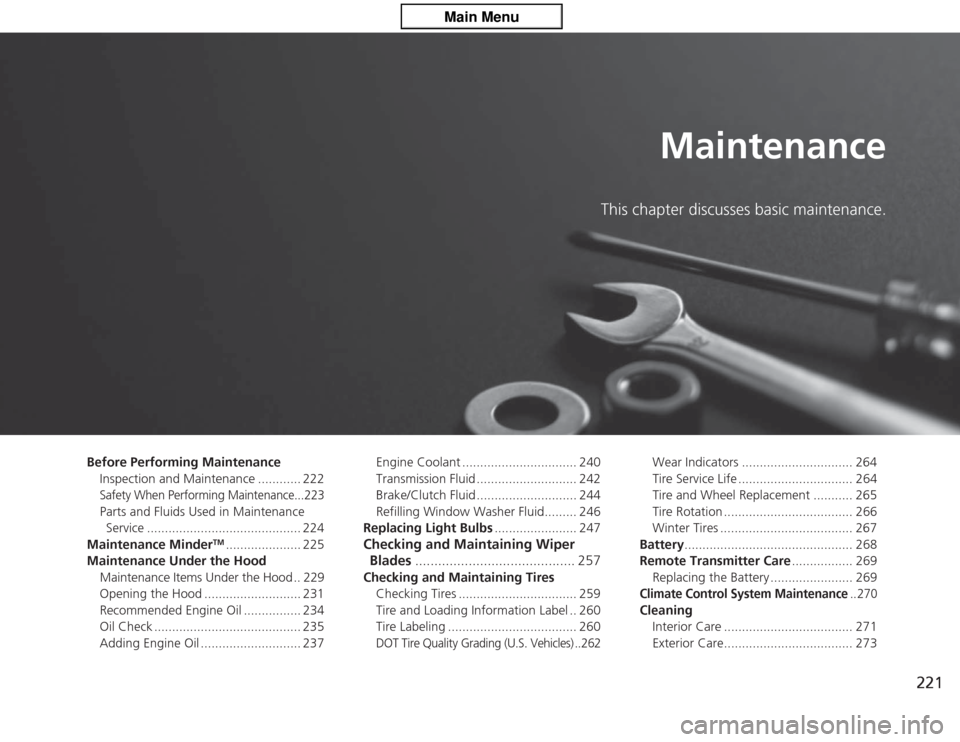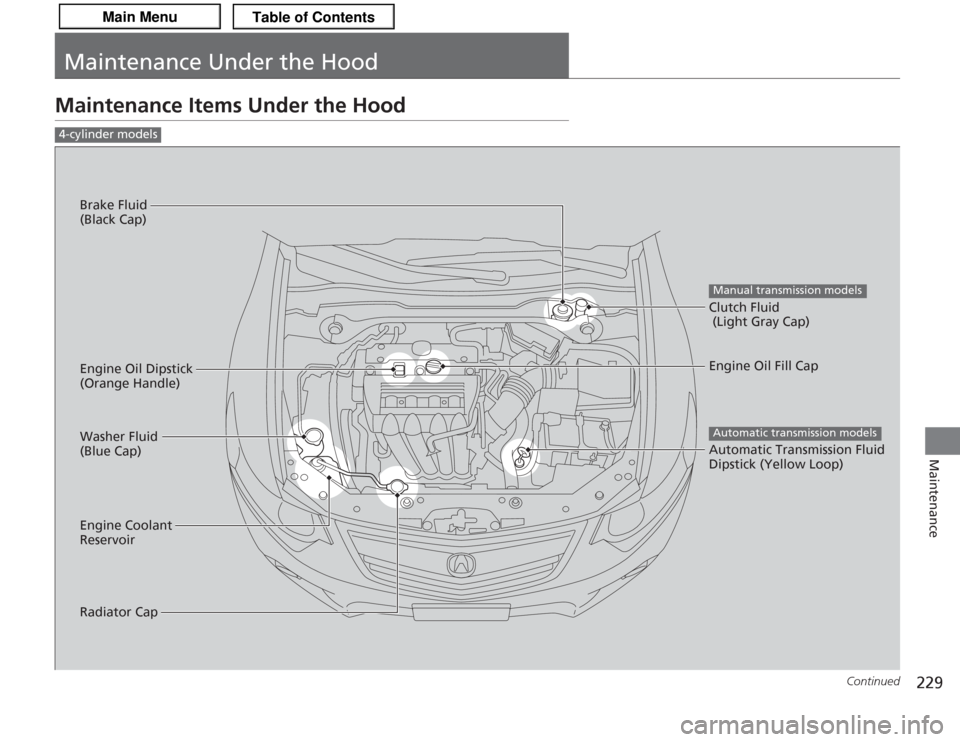engine coolant Acura TSX 2013 Owner's Manual
[x] Cancel search | Manufacturer: ACURA, Model Year: 2013, Model line: TSX, Model: Acura TSX 2013Pages: 325, PDF Size: 8.61 MB
Page 16 of 325

15Quick Reference Guide
Maintenance
(P 221)
Under the Hood
(P 229)
● Check engine oil, engine coolant, and windshield washer
fluid. Add when necessary.
● Check brake fluid and clutch fluid.
● Check the battery regularly.
a
Pull the hood release handle under the corner of the
dashboard.
b
Locate the hood latch lever, pull the lever up, and lift up
the hood.
c
When finished, close the hood and make sure it is firmly
locked in place.
Lights
(P247)
● Inspect all lights regularly.
Wiper Blades
(P257)
● Replace blades if they leave streaks
across the windshield.
Tires
(P259)
● Inspect tires and wheels regularly.
● Check tire pressures regularly.
● Install snow tires for winter
driving.
Page 73 of 325

72
uuIndicators uMulti-Information Display Warn ing and Information Messages
Instrument Panel
Multi-Information Display Warning and Information MessagesThe following messages appear only on the multi-information display. Pres s the (information) button to see the message again
with the system message indicator on.
Message
Condition
Explanation
●
Appears when the engine coolant temperature gets
abnormally high.
2 Overheating P. 288
●
Appears when the fuel fill cap is loose or is not
installed.
2Tighten Fuel Fill Cap Message P. 291
●
Appears if there is a problem with the DRL system.
●
Have your vehicle checked by a dealer.
2Daytime Running Lights P. 107
●
Appears when washer fluid gets low.
●
Refill washer fluid.
2Refilling Window Washer Fluid P. 246
Canadian models
Page 76 of 325

75Instrument Panel
Gauges and Multi-Information DisplayGaugesGauges include the speedometer, tachometer, fuel gauge, and temperature gauge.
They are displayed when the ignition switch is in ON
(w
.
Displays your driving speed in mph (U.S.) or km/h (Canada).
Displays the amount of fuel left in the fuel tank.
Displays the temperature of the engine coolant.
Shows the number of engine revolutions per minute.
■
Speedometer
■
Fuel Gauge
■
Temperature Gauge
■
Tachometer
1 Fuel Gauge
NOTICEYou should refuel when the reading approaches .
Running out of fuel can cause the engine to misfire,
damaging the catalytic converter.
The actual amount of remaining fuel may differ from
the fuel gauge reading.
E
1 Temperature Gauge
NOTICEDriving with the temperature gauge pointer in the
upper zone can cause serious engine damage. Pull
safely to the side of the road and allow engine
temperature to return to normal.
2 Overheating P. 288
Page 192 of 325

191
Continued
Driving
When DrivingStarting the Engine
1.Make sure the parking brake is applied.
2. Check that the shift lever is in
(P
, then
depress the brake pedal.
u Although it is possible to start the vehicle
in
(N
, it is safer to start it in
(P
.
2. Check that the shift lever is in
(N
. Then
depress the brake pedal with your right
foot, and the clutch pedal with your left
foot.
u The clutch pedal must be fully depressed
to start the engine.
1Starting the Engine
Keep your foot firmly on the brake pedal when
starting the engine.
The engine is harder to start in cold weather and in
thinner air found at altitudes above 8,000 feet (2,400
meters).
When starting the engine in cold weather, turn off all
electrical accessories such as the lights, climate
control system, and rear defogger in order to reduce
battery drain.
If you live in a region where winter is extremely cold,
an engine block heater will improve starting and
warming of the engine. If temperatures consistently
below -22°F (-30°C) are expected, the coolant
mixture should be changed to a higher concentration
to prevent freezing. Consult a dealer for details.
If exhaust sounds abnormal or you can smell exhaust
gas inside the vehicle, have your vehicle checked by a
dealer. There may be a problem with the engine or
exhaust system.
The immobilizer system protects your vehicle from
theft.
If an improperly coded device is used, the engine’s
fuel system is disabled.
2 Immobilizer System P. 98
Brake Pedal
Automatic transmission models
Brake Pedal
Clutch Pedal
Manual transmission models
Page 222 of 325

221
Maintenance
This chapter discusses basic maintenance.
Before Performing MaintenanceInspection and Maintenance ............ 222
Safety When Performing Maintenance...223Parts and Fluids Used in Maintenance Service ........................................... 224
Maintenance Minder
TM
..................... 225
Maintenance Under the Hood Maintenance Items Under the Hood .. 229
Opening the Hood ........................... 231
Recommended Engine Oil ................ 234
Oil Check ......................................... 235
Adding Engine Oil ............................ 237 Engine Coolant ................................ 240
Transmission Fluid ............................ 242
Brake/Clutch Fluid ............................ 244
Refilling Window Washer Fluid......... 246
Replacing Light Bulbs ....................... 247
Checking and Maintaining Wiper
Blades .......................................... 257Checking and Maintaining Tires
Checking Tires ................................. 259
Tire and Loading Information Label .. 260
Tire Labeling .................................... 260
DOT Tire Quality Grading (U.S. Vehicles) ..262
Wear Indicators ............................... 264
Tire Service Life ................................ 264
Tire and Wheel Replacement ........... 265
Tire Rotation .................................... 266
Winter Tires ..................................... 267
Battery ............................................... 268
Remote Transmitter Care ................. 269
Replacing the Battery ....................... 269
Climate Control System Maintenance
.. 270
Cleaning Interior Care .................................... 271
Exterior Care.................................... 273
Page 228 of 325

227
uuMaintenance Minder
TMu
Continued
Maintenance
■
Maintenance Service Items
1Maintenance Service Items•Independent of the Maintenance Minder
information, replace the brake fluid every 3 years.•Inspect idle speed every 160,000 miles (256,000
km).•Adjust the valves during services A, B, 1, 2, or 3 if
they are noisy.
Maintenance Minder Message
System Message
Indicator
Sub Items
Main Items
*1: If message, SERVICE DUE NOW does not appear more than 12 months after the display is reset,
change the engine oil every year.
*2: If you drive primarily in dusty conditions, replace the air cleaner element every 15,000 miles (24,000 km).
*3: If you drive primarily in urban areas that have high concentrations of soot in the air from industry and from diesel-powered vehicles, replace the dust and pollen filter every 15,000 miles (24,000 km).CODE
Maintenance Main Items
A
●
Replace engine oil
*1
B
●
Replace engine oil
*1 and oil filter
●
Inspect front and rear brakes
●
Check parking brake adjustment
●
Inspect tie rod ends, steering gear box, and boots
●
Inspect suspension components
●
Inspect driveshaft boots
●
Inspect brake hoses and lines (Including ABS)
●
Inspect all fluid levels and condition of fluids
●
Inspect exhaust system
#
●
Inspect fuel lines and connections
#
*4: Driving in mountainous areas at very low vehicle speeds or trailer towing results in higher transmission temperatures. This requires transmission fluid changes more frequently than recommended by the
Maintenance Minder. If you regularly drive your vehicle under these conditions, have the transmission
fluid changed at 60,000 miles (100,000 km), then every 30,000 miles (48,000 km). (For A/T only.)
*5: If you drive regularly in very high temperatures (over 110°F, 43 °C), in very low temperatures (under -20°F, -29°C), or tow a trailer, replace every 60,000 miles/100,000 km. (6-cylinder models only)
# : See information on maintenance and emissions warranty.CODE
Maintenance Sub Items
1
●
Rotate tires
2
●
Replace air cleaner element
*2
●
Replace dust and pollen filter
*3
●
Inspect drive belt
3
●
Replace transmission fluid
*4
4
●
Replace spark plugs
●
Replace timing belt and inspect water pump
*5
●
Inspect valve clearance
5
●
Replace engine coolant
Page 230 of 325

229
Continued
Maintenance
Maintenance Under the HoodMaintenance Items Under the Hood4-cylinder models
Brake Fluid
(Black Cap)
Engine Coolant
Reservoir
Radiator Cap Washer Fluid
(Blue Cap) Engine Oil Dipstick
(Orange Handle)Clutch Fluid
(Light Gray Cap)
Manual transmission modelsEngine Oil Fill Cap
Automatic Transmission Fluid
Dipstick (Yellow Loop)Automatic transmission models
Page 231 of 325

230
uuMaintenance Under the Hood uMaintenance Items Under the Hood
Maintenance
6-cylinder models
Engine Oil Dipstick
(Orange Loop)
Washer Fluid
(Blue Cap)
Engine Coolant
Reservoir
*
Radiator Cap
*
Brake Fluid
(Black Cap)
Engine Oil Fill Cap
Automatic Transmission
Fluid Dipstick
(Yellow Loop)
*: Located under the cover
Page 241 of 325

240
uuMaintenance Under the Hood uEngine Coolant
Maintenance
Engine CoolantThis coolant is premixed with 50% antifreeze and 50% water. Do not add any
straight antifreeze or water.
We recommend you check the engine coolant level every time you refuel. Check the
reserve tank first. If it is completely empty, also check the coolant level in the
radiator. Add the engine coolant accordingly.
1.Remove the right-side engine compartment
cover.
2 Engine Compartment Covers P. 233
2.Check the amount of coolant in the reserve
tank.
3. If the coolant level is below the MIN mark,
add the specified coolant until it reaches
the MAX mark.
4. Inspect the cooling system for leaks.
Specified coolant: Honda Long Life Antifreeze/Coolant Type 2■
Reserve Tank
1Engine Coolant
NOTICEIf temperatures consistently below -22°F (-30°C) are
expected, the coolant mixture should be changed to
a higher concentration. Consult a dealer for more
information.
If Honda antifreeze/coolant is not available, you may
use another major brand non-silicate coolant as a
temporary replacement. Check that it is a high quality
coolant recommended for aluminum engines.
Continued use of any non-Honda coolant can result
in corrosion, causing the cooling system to
malfunction or fail. Have the cooling system flushed
and refilled with Honda antifreeze/coolant as soon as
possible.
Do not add rust inhibitors or other additives to your
vehicle’s cooling system. They may not be compatible
with the coolant or with the engine components.4-cylinder models
Reserve Tank
MAX MIN
6-cylinder modelsAll models
Reserve Tank
Page 242 of 325

241
uuMaintenance Under the Hood uEngine Coolant
Maintenance
1. Remove the radiator cap cover.
2. Make sure the engine and radiator are cool.
3. Turn the radiator cap counterclockwise and
relieve any pressure in the coolant system.
Do not push the cap down when turning.
4. Push down and turn the radiator cap
counterclockwise to remove it.
5. The coolant level should be up to the base
of the filler neck. Add coolant if it is low.
6. Put the radiator cap back on, and tighten it
fully.
7. Pour coolant into the reserve tank until it
reaches the MAX mark. Put the cap back
on the reserve tank.
■
Radiator
1 Radiator
NOTICEPour the fluid slowly and carefully so you do not spill
any. Clean up any spills immediately; they can
damage components in the engine compartment.
3
WARNING
Removing the radiator cap while the
engine is hot can cause the coolant to spray
out, seriously scalding you.
Always let the engine and radiator cool
down before removing the radiator cap.
Radiator Cap
6-cylinder modelsAll models